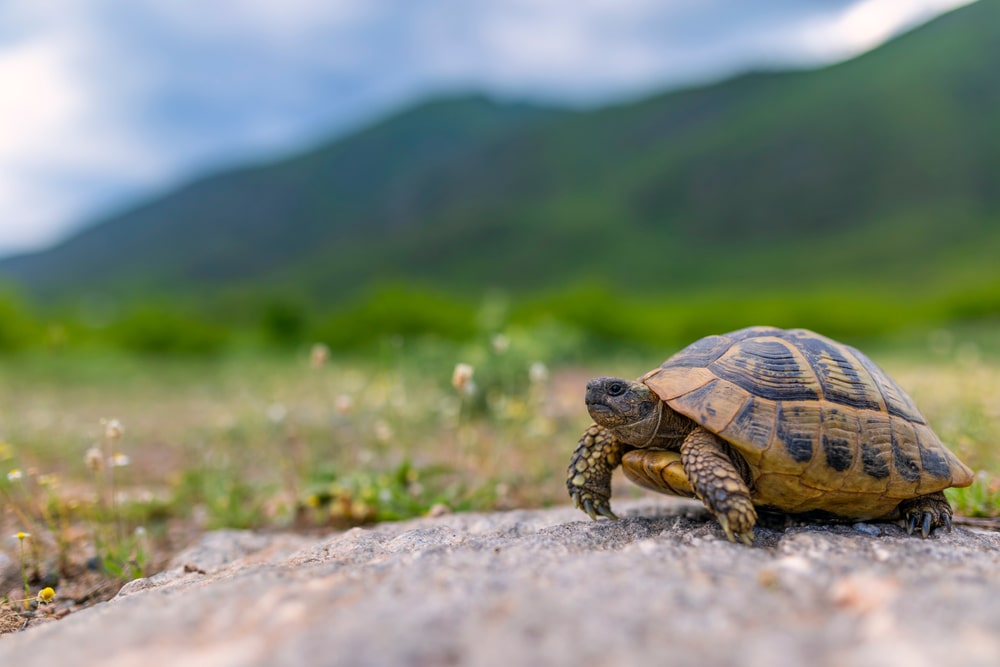
The United States is home to almost 100 species of turtles. Michigan has 41.5% of its total area occupied by water. It has over 60,000 inland lakes and ponds, making it the perfect environment for turtles. Ten native species chose this state as their home.
Some of them are very common; others are a rare sight or under protection. Turtles play an important role in the health of diverse habitats, including wetlands and freshwater ecosystems. They can help restore ecosystems and be a food source for other animals.
Read on to explore the 10 native species of turtles found in Michigan, that live both on land or underwater.
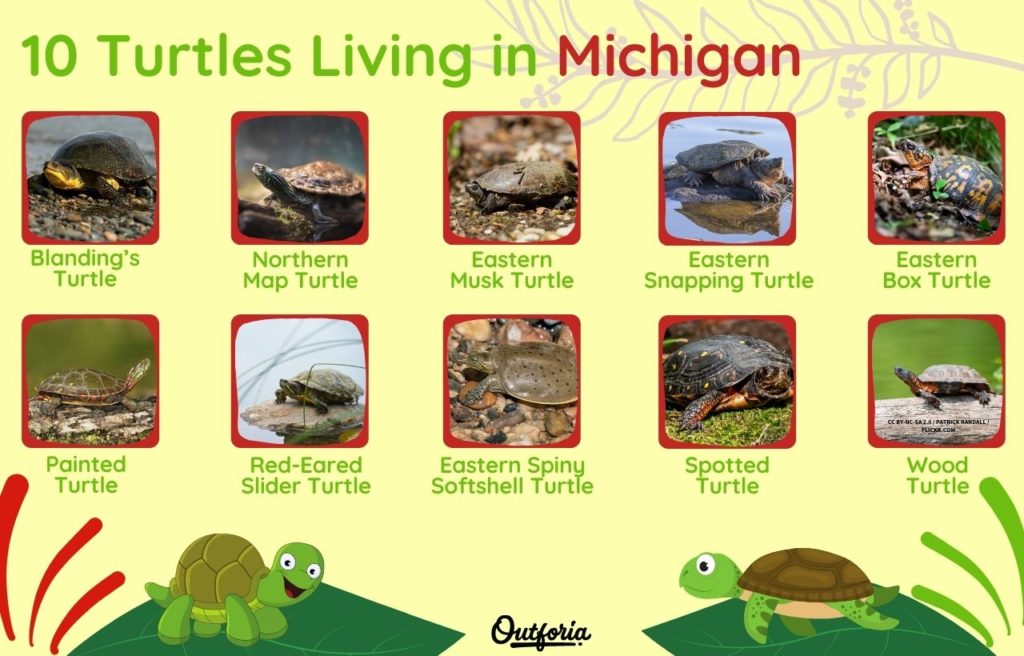
You May Also Like: These Are The Fish You Can Find In Lake Michigan complete with Guide, Facts, Infographics, and more!
Fun Facts
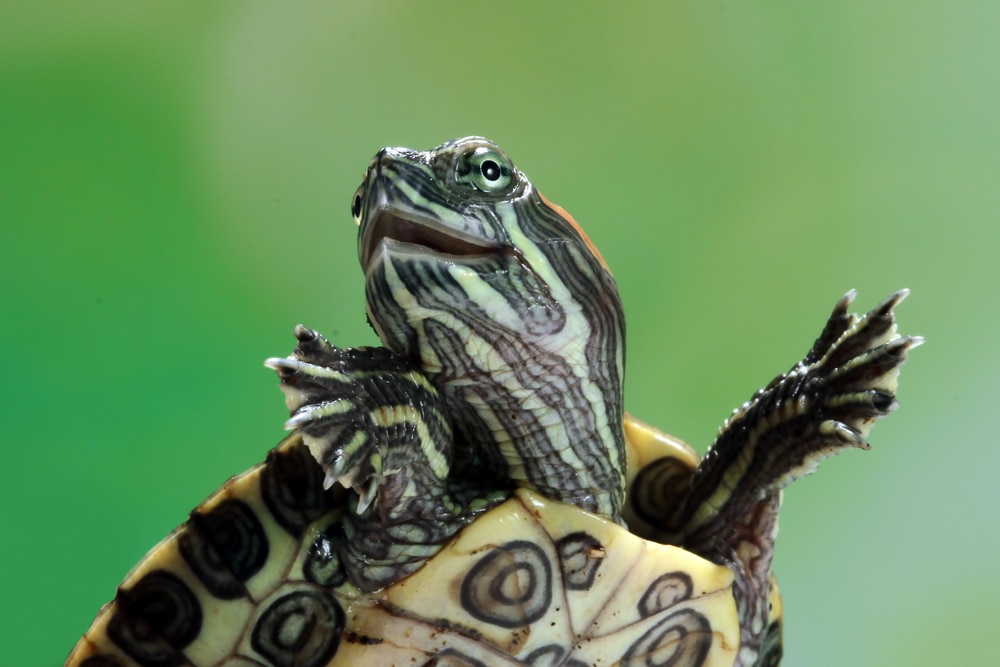
The Snapping Turtle is the largest type of turtle found in Michigan. It can grow up to 18 inches, and it can leave quite a mark on you as it has a powerful bite.
The Eastern Musk Turtle has the Stinkpot nickname because of the foul odor that it releases when it feels threatened. This turtle is a good climber and can easily climb trees.
You May Also Like: Learn The Difference Between Turtle and Tortoise Here Complete with Photos, Infographics, Facts, and more!
10 Turtles in Michigan
1. Blanding’s Turtle (Emydoidea blandingii)
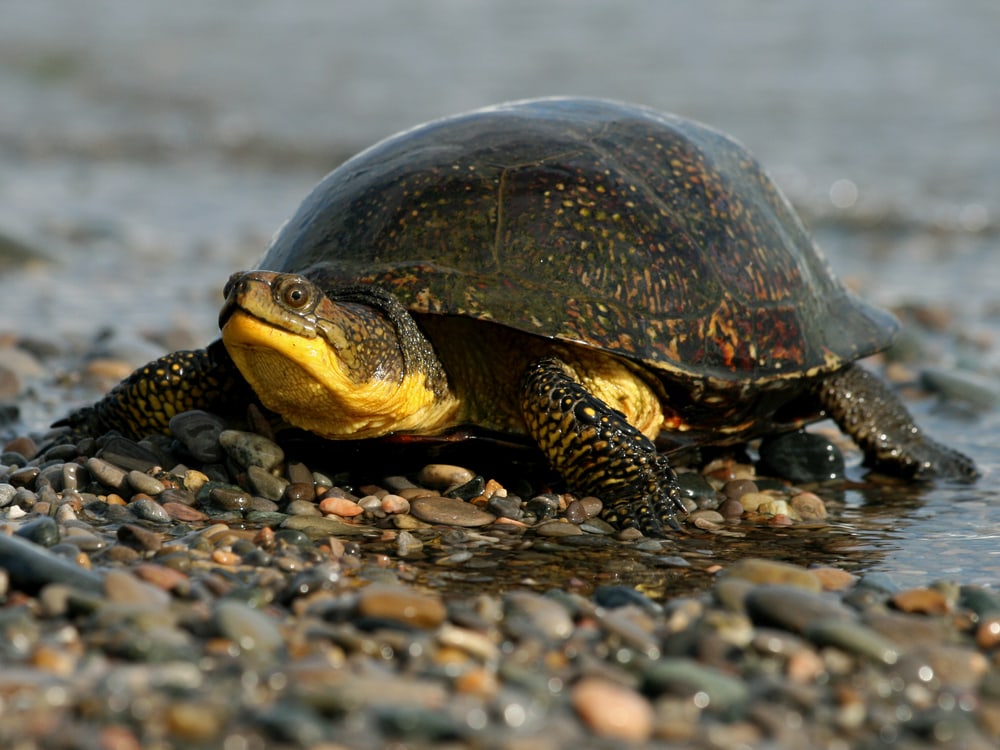
Description
Population: unknown, with numbers declining
State Status: Special Concern
Carapace Size: 6 to 11 inches (15-28 cm)
Weight: 1.6 to 3 lb ( 0.72- 1.3 kg)
Color: Top shell is black with yellow spots and streaks, dome-like shape. The bottom shell is yellow with dark spots at the outer corners
The Blanding’s Turtle is a medium-sized turtle with a long neck. You can distinguish it by its coloring on the chin and neck as they are bright yellow. The turtle’s head is dark with yellow spots. This species looks like it has a permanent grin because of its rounded nose and indented upper jaw.
Life Cycle & Reproduction
Lifespan: up to 80 years
The breeding starts in April and ends in late October. Nesting usually takes place between May and the end of June. Since these turtles take a long time to reach adulthood, they don’t start reproducing until they’re 18-20 years old.
Female turtles usually chose their nest near hill areas as opposed to wetlands, as they like sunny areas with well-drained soil. Sometimes the turtles can choose to make their nest in gardens and lawns if their nesting habitat is not considered safe.
Females usually lay 3 to 19 eggs and the incubation period is between 80 to 128 days. After the female buries the eggs, she leaves them. The males watch them until they hatch.
Habitat & Range
Habitat: These turtles are semi-aquatic and prefer shallow waters with plenty of aquatic vegetation. You can spot this species in ponds, marshes, swamps, bogs, lake shallows, and river backwaters. They also like to spend time on land in the spring and summer as these are the mating and nesting seasons.
Range: From Northeast Maine to Northwest South Dakota and Nebraska
Diet
They are omnivore turtles and prefer to eat algae, aquatic plants, fish eggs, frogs, and crustaceans.
Predators & Threats
The Blanding’s Turtles have been decreasing in population due to threats to their marsh and wetlands habitats.Their predators include short-tailed shrews, striped skunks, opossums, raccoons, and foxes. The predators seek out eggs or juvenile turtles.
2. Northern Map Turtle (Graptemys geographica)
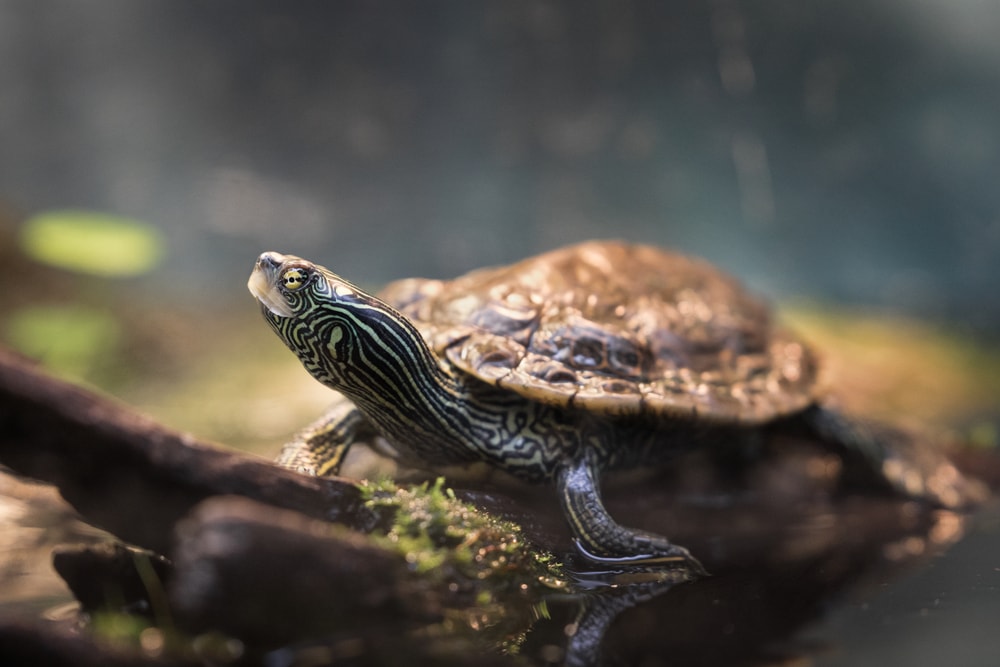
Description
Population: Unknown
State Status: Normal
Carapace Size: 3.5 to 10 inches (8.8-25.4 cm) Females are larger than males
Weight: 0.3 to 5.5 lb (up to 2.5 kg)
Color: Dark brown or olive shells with yellow markings that resemble maps. They have small yellow dots behind their eyes.
When the turtle gets older, the markings start to disappear. The bottom shell is light-colored and the skin has thin light-colored stripes.
Life Cycle & Reproduction
Lifespan: from 30 to 50 years
The Northern Map Turtles nest multiple times a year, from early spring until late summer. The mating ritual is usually underwater. The female usually lays multiple clutches in a breeding season.
The clutch ranges from 6 to 20 eggs and the incubation period is between 50 to 70 days. The turtles hatch in late August or September.
Habitat & Range
Habitat: They are very common turtles in Michigan. These turtles are mainly aquatic and rarely come out of the water. They prefer ponds, river bottoms, and lakes with lots of vegetation.
Range: West through the Great Lakes and Northwestern Vermont, Southern Wisconsin, Northeastern Oklahoma.
Diet
The Northern Map Turtles are omnivorous, and they will eat aquatic insects, fruits, aquatic vegetation, snails and dead fish. Females prefer clams and crayfish, while males like to eat small crustaceans.
Predators & Threats
Common predators include raccoons, skunks, foxes, North American river otters and coyotes.
These turtles are common around the Great Lakes, but they have been driven away because of the heavy pollution on urban rivers.
3. Eastern Musk Turtle (Sternotherus odoratus)
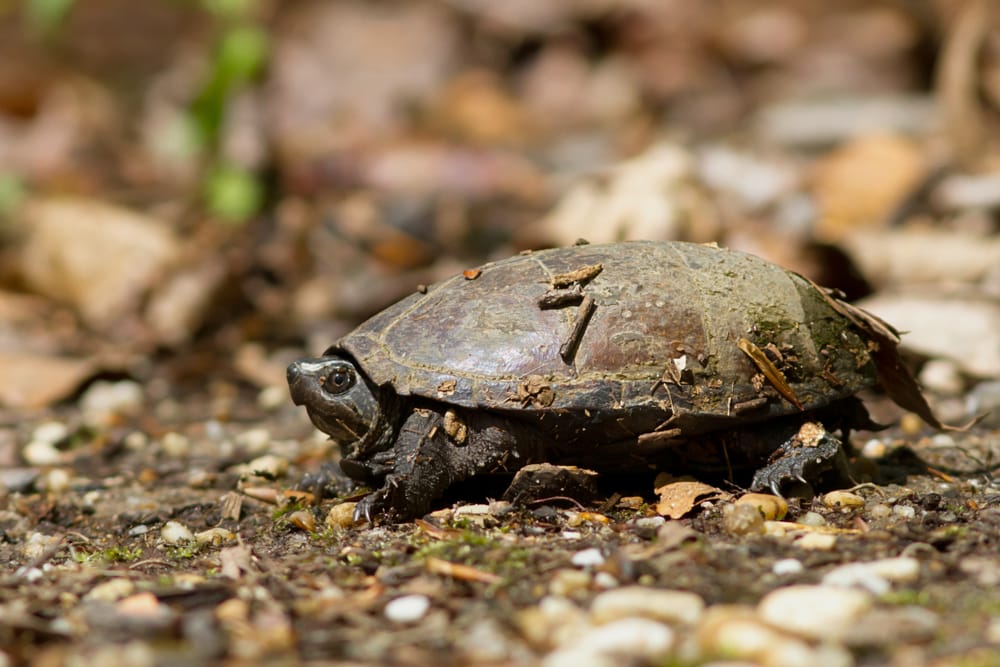
Description
Population: unknown but it experiences declines/ extirpation
State Status: Least concern
Carapace Size: 3 to 4.5 inches (7.6-11.4 cm)
Weight: 1 to 2 lb (0.4-0.9 kg)
Color: Carapaces have brown, gray, or black colors with dark spots. They have 2 yellow stripes between the eyes and the nose. They present yellow stripes alongside the head and neck but they fade with age
The Eastern Musk Turtle is fairly common in Michigan. They are small and are distinguishable by the stripes on their heads. The turtles are nicknamed “Stinkpots” due to the strong odor they release against predators.
Life Cycle & Reproduction
Lifespan: between 30 to 50 years
They begin to nest in late May until August. The incubation period usually lasts up to 75 days.
Habitat & Range
Habitat: These turtles are mostly aquatic and can be found in still or slow-moving waters. They like to be in waters with soft muddy or sandy bottoms.
Diet
As the majority of turtles, they are omnivores. They prefer to eat small aquatic or semi-aquatic animals and aquatic plants. They also like to eat whatever fruits and vegetables they can find. As they aren’t good swimmers, they don’t usually chase their food.
Predators & Threats
Their population has been on the decline due to residential development.
They usually climb trees to escape their predators. The turtles’ most common predators are foxes, raccoons, skunks and birds.
4. Eastern Snapping Turtle (Chelydra serpentina)
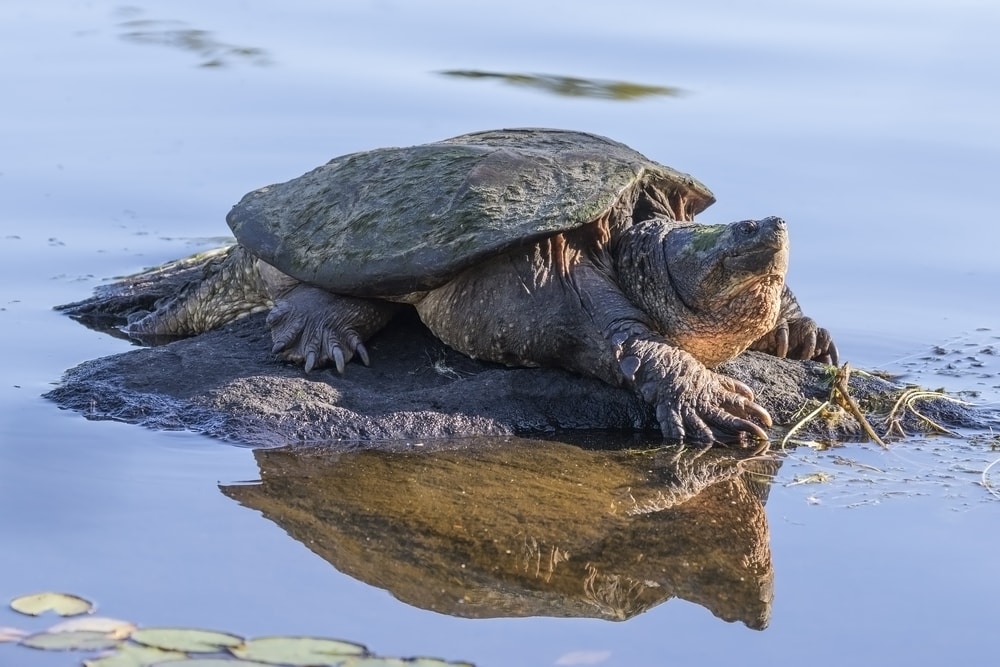
Description
Population: Unknown
State Status: Normal
Carapace Size: 8-18.5 inches (20.3-47 cm)
Weight: 10 to 35 lbs (4.5-16 kg)
Color: Their carapace is black, brown, or olive. The skin color on the top of the head, arms and legs is usually dark, brown or olive. The plastron is yellow or gray
These turtles can be very aggressive, so you don’t want to bother them as they will bite when they feel threatened. Their mouths look like hooks and have a strong bite. This species also has powerful claws and rigid tails.
Life Cycle & Reproduction
Lifespan: up to 50 years
The mating season starts in late March and ends in November. The nesting period is between May and June. The female usually digs the nest in soft sand. She lays only one clutch per breeding season, between 25 to 45 spherical eggs. The incubation period is between 75 to 95 days.
Habitat & Range
Habitat: They like to hide so they chose to live in any body of freshwater as long as they have muddy bottoms and abundant vegetation.
Range: From Southern Alberta to the Gulf of Mexico and central Texas.
Diet
They are omnivorous and usually eat underwater vegetation and fish. They prefer to eat fish, birds and small mammals.
Predators & Threats
They don’t have predators once they reach full maturity. However, their eggs and hatchlings can be eaten by other turtles, crows, raccoons and water snakes.
5. Eastern Box Turtle (Terappene carolina carolina)
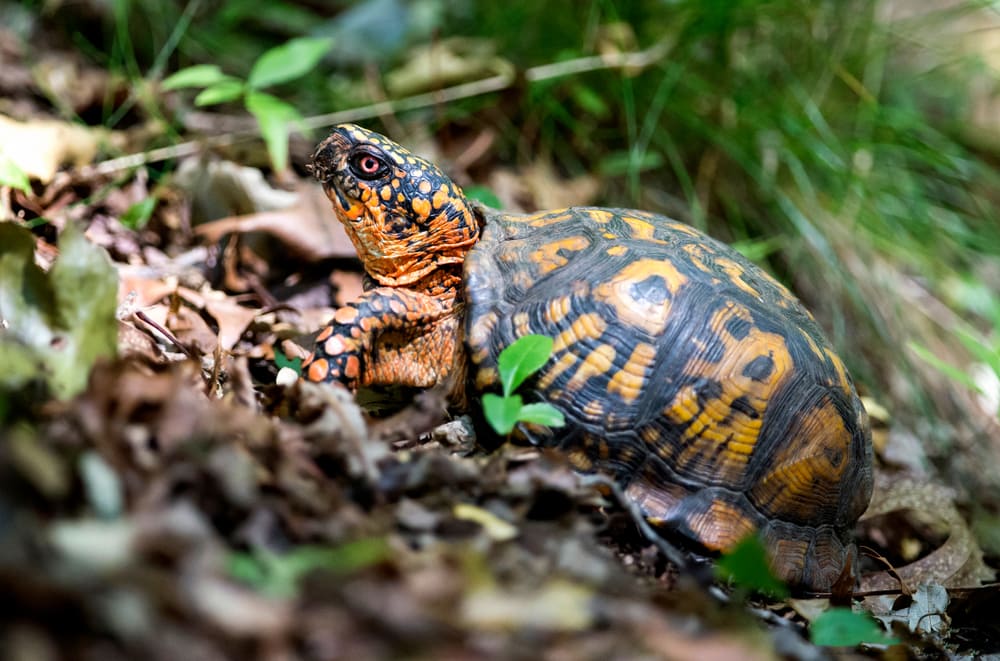
Description
Population: Unknown
State Status: Special Concern
Carapace Size: 4 to 7 inches (10-18 cm)
Weight: up to 2 lbs (1 kg)
Color: Brown or black with yellow or orange patterns. The plastron is yellow, brown or black
The Eastern Box turtle is a tiny turtle with a high dome carapace shape, while the bottom part of the shell is hinged. Females are usually smaller than males, and they have darker colors. Their eye color is brown, while the males have red or pink eyes.
Life Cycle & Reproduction
Lifespan: between 50 and 100 years
Breeding starts from the first week of May until October, while nesting is between June to July.
After copulation, males sometimes fall backward and die of starvation because they cannot lift themselves.
The female lays from 3 to 8 eggs and the incubation lasts 3 months.
Habitat & Range
Habitat: This type of turtle is the only terrestrial species in Michigan. It prefers forested habitats, deciduous or mixed woodlands. They can also be seen in marshy or grassland fields and meadows.
Range: Only in North America, Southern Main to Florida and west to Michigan, Illinois and Texas.
Diet
They usually roam up to 50 meters (164 feet) to find food. They are omnivores and prefer to eat snails, insects, slugs, worms, frogs, salamanders and snakes.
Predators & Threats
They don’t have natural predators because this species can close its shell.
They are a species of concern because their natural habitat has been reduced or threatened. These turtles are also involved in the pet trade, which reduces their number in the wild.
6. Painted Turtle (Chrysemys picta)
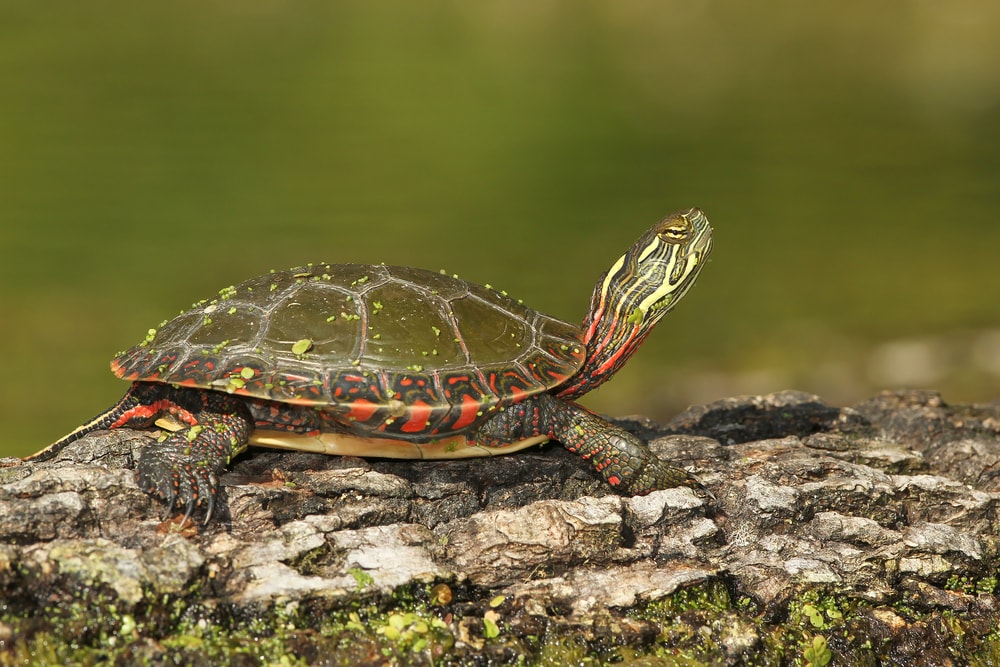
Description
Population: Unknown
State Status: Normal
Carapace Size: 4 to 10 inches (10-25 cm)
Weight: 0.6 to 1.1 lbs (300-500 g)
Color: Black and olives carapaces with red spots. They have red and orange colorings on their face and bodies. The plastron is yellow with orange and pink spots. The Head and throat have yellow stripes
The Painted Turtle is the easiest species to recognize in Michigan due to its unique coloring. There are two common native subspecies in this state, the Midland Painted and the Western Painted turtle.
The Western Painted turtle have darker plastrons, and their shell is a shade of olive green. The Midland Painted turtle has a dark patch in the middle of its plastron.
Life Cycle & Reproduction
Lifespan: 30 to 50 years
Turtles hibernate during the winter months. Once they wake up, the mating season starts, from spring until late summer. The female lays 4 to 15 eggs in a hole made in soft sand. They cover the hole and leave the eggs. The young turtles need to dig out of the hole by themselves and are immediately independent.
Habitat & Range
Habitat: They are mainly aquatic turtles and prefer freshwaters with muddy bottoms. They can live in highly polluted waters like ponds, marshes and small lakes.
Region: Most common turtles in North America, ranging from southern Canada to northern Mexico.
Diet
Turtles are omnivorous meaning they eat fruits and meat. The Painted turtles prefer to eat mollusks, frogs, and underwater insects and plants.
Predators & Threats
Their main predators are raccoons, foxes, minks and North American river otters.
7. Red-Eared Slider Turtle (Trachemys scripta elegans)
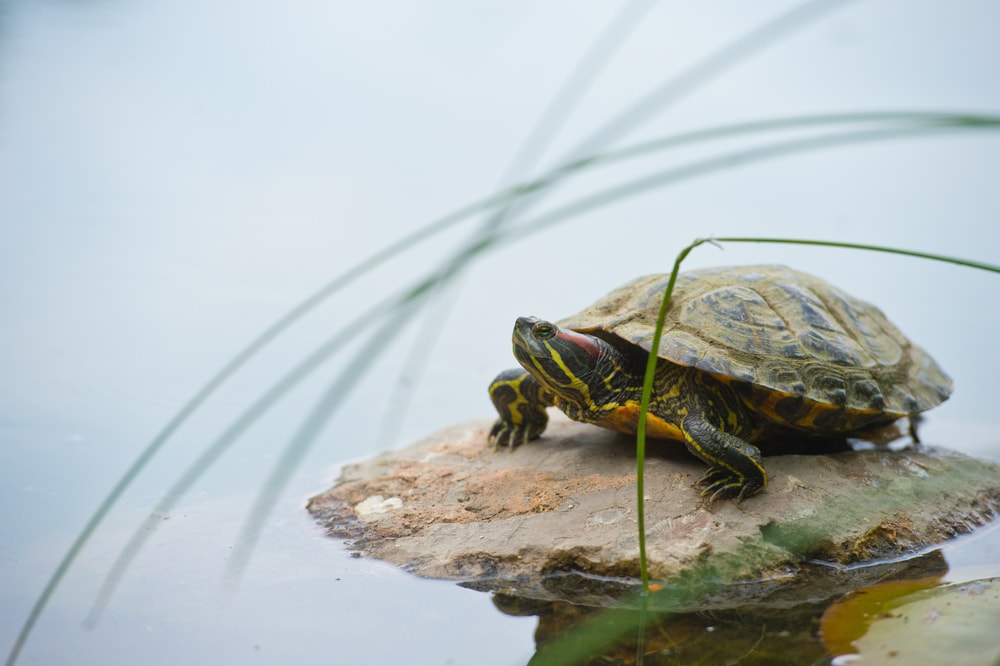
Description
Population: Unknown
State Status: Normal
Carapace Size: 7 to 11 inches (18-28 cm)
Weight: 3 to 6 lb (1.3-3 kg)
Color: The carapace is brown or olive with yellow and black stripes. The plastron is yellow with dark spots. The head and legs are black or green with black and yellow stripes. They have red patches behind their eyes
They are the most common turtle on the pet market.
Life Cycle & Reproduction
Lifespan: 20 to 40 years
The Red-eared slider turtle starts courting in water, and nesting begins from April until July. One clutch is between 2 to 23 eggs. A female can lay up to 5 clutches per nesting season. Turtles hatch in late July or early autumn.
Habitat & Range
Habitat: They prefer to live in freshwaters with soft bottoms. They can be often spotted in warm slow-moving waters.
Range: From Illinois to the Gulf of Mexico
Diet
This species is omnivorous and likes to eat algae, plants, snails, clams and insects. Turtles’ diets are very varied especially if they are semi-aquatic.
Predators & Threats
Their most common predators are alligators, crows, raccoons, otters and coyotes.
8. Eastern Spiny Softshell Turtle (Apalone spinifera spinifera)
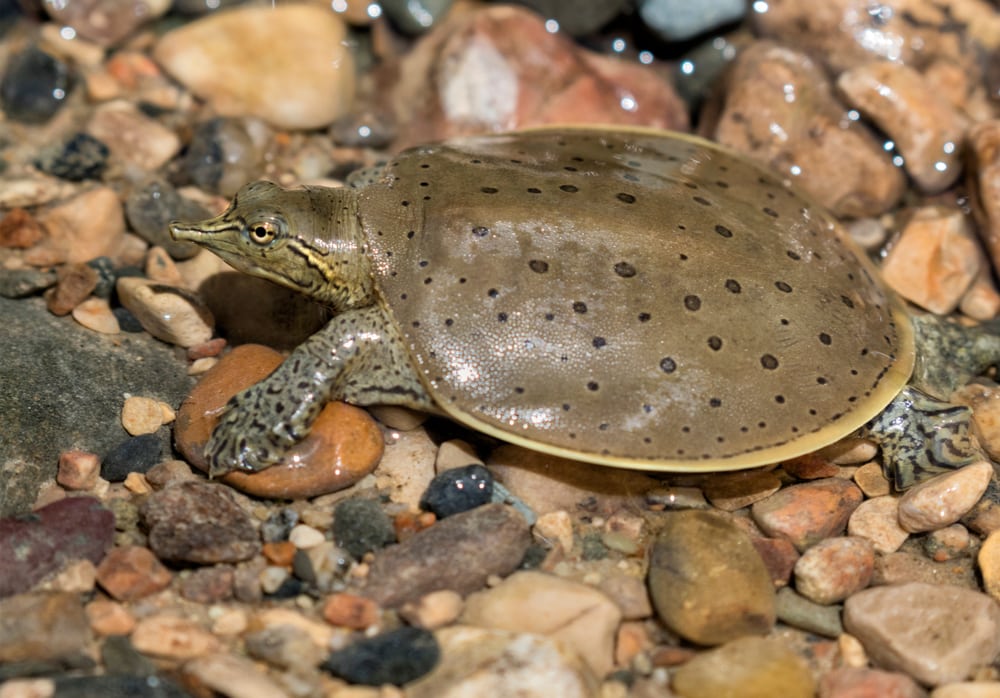
Description
Population: Unknown
State Status: Normal
Carapace Size: 5 to 21 inches
Weight: up to 25lb (11kg)
Color: The carapace is brown, olive or gray with black spots. The carapace has a sandpaper texture with a row of spines along the back
They are feisty turtles, and they will scratch and bite if you try to catch them. They can breathe underwater by absorbing oxygen throughout the skin of their throat. They are great swimmers due to their flat shell, webbed feet and long claws.
This turtle is highly distinguishable by its nose form as it has a long tube snorkel-like shape. It uses the nose to poke out of the water while completely submerged. It is a defense mechanism against predators.
Life Cycle & Reproduction
Lifespan: 20 to 50 years
They need a sandy place for the nesting season. They burrow their eggs in soft sand. The nesting season begins in March and ends in early June. The eggs usually hatch in 80 days.
Habitat & Range
Habitat: They show up in the western part of Michigan. They prefer to stay in lakes, rivers and streams with muddy bottoms and little vegetation.
Diet
They are carnivorous and not picky eaters either. They will eat anything underwater that they can swallow. They will go for insects, crayfish and small fish.
The Spiny Softshell turtles also have a tactic for catching food, as they like to bury themselves into the muddy or sandy bottom, having their head uncovered and snatching anything that swims nearby.
Predators & Threats
As they are great swimmers they can swim away from predators and bury themselves in the muddy bottoms.
9. Spotted Turtle (Clemmys guttata)
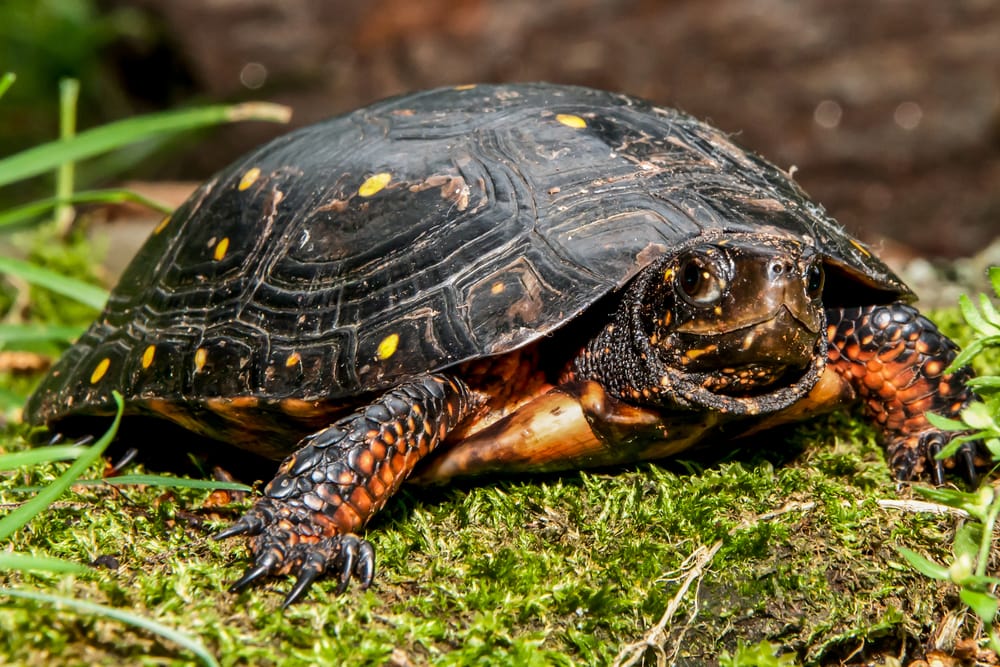
Description
Population: Unknown but in decline
State Status: Threatened, protected species
Carapace Size: 3.5 to 5.4 (9-14 cm)
Weight: 1.5 to 3.5 lb ( 0.6-1.5 kg)
Color: The black or brown carapace spots small yellow dots. The plastron is yellow or orange
The Spotted Turtle is a small species endangered due to pet trading and habitat destruction. In the wild, they are hostile hunters that go for live prey.
Life Cycle & Reproduction
Lifespan: up to 70 years
The male starts courting the female underwater, where he chases her while biting her legs and carapace. Nesting starts from May until June.
The female lays one clutch per year, around 1 to 8 eggs each time. Interestingly, the weather determines the sex of the hatchlings. Colder weather produces more male hatchlings, while warmer days produce only females.
Habitat & Range
Habitat: These turtles prefer clean bodies of slow or standing water. They like muddy bottoms with plenty of vegetation. Spotted turtles are aquatic, although they can live on land in open habitats.
In spring, they like basking on logs, while at night or during hot weather, they choose mammal burrows.
Region: From Canada to Northern Florida including the Midwest
Diet
The Spotted turtles are omnivore and they like to eat algae, leaves of aquatic plants, worms, mollusks and crustaceans.
Predators & Threats
Their population is on the decline due to habitat loss and human intrusion. The common predators are raccoons, common Snapping turtles and foxes. These mostly go for eggs and juveniles.
10. Wood Turtle (Glytemys insculpta)
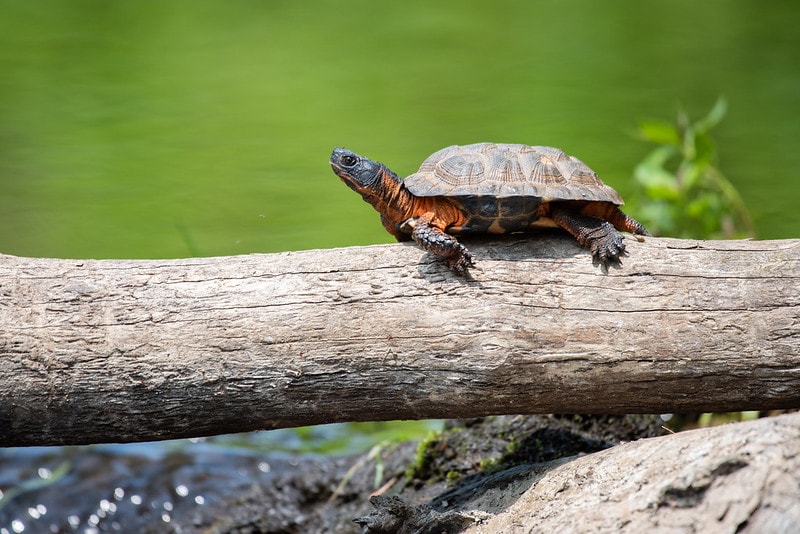
Description
Population: Unknown, on decline
State Status: Special concern
Carapace Size: 6 to 10 inches (15-25 cm)
Weight: 1.5 to 2.5 lbs (0.6-1.1 kg)
Color: The carapace is brown with yellow and black lines on the edges. The plastron is yellow with dark patches on the outer edges
The Wood Turtle is a medium-sized species that is distinguishable by the shape of its carapace and unhinged plastron. The limbs of this turtle have prominent scales and have yellow or orange patches.
Life Cycle & Reproduction
Lifespan: up to 60 years
These species reach maturity when they are 20 years old. The courtship starts with a mating dance performed by both sexes, and it usually occurs from May until September. The female creates a nest that is 5 inches deep.
The female lays one clutch per year, between 3 to 18 eggs. Incubation lasts up to 70 days. Hatchlings emerge in September and run into water.
Habitat & Range
Habitat: This species prefers to be in moving water like rivers and streams. They can also live in deciduous and coniferous forests that contain herbs and shrubs.
Range: From Eastern Canada to Northeastern USA
Diet
The Wood Turtle is omnivore and likes to eat leaves, flowers, berries, fungi, snails and worms.
Predators & Threats
They don’t really have predators as adults, however, raccoons prey on their nests.
You May Also Like: 14 Frogs Of Michigan: ID Guide With Photos And Calls
Cultural References – Myths & Legends
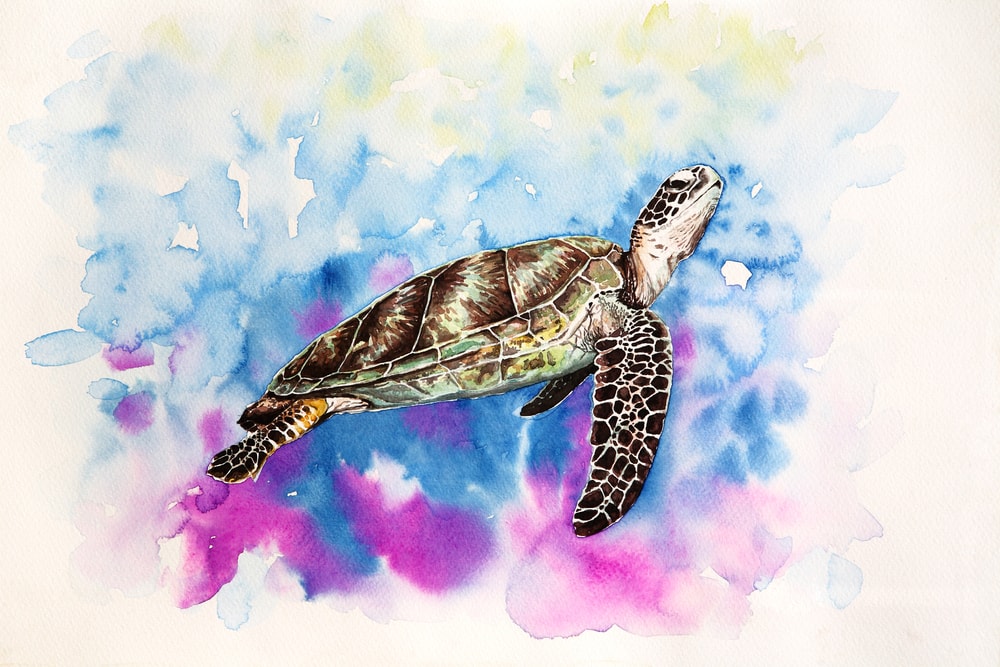
Mesopotamia
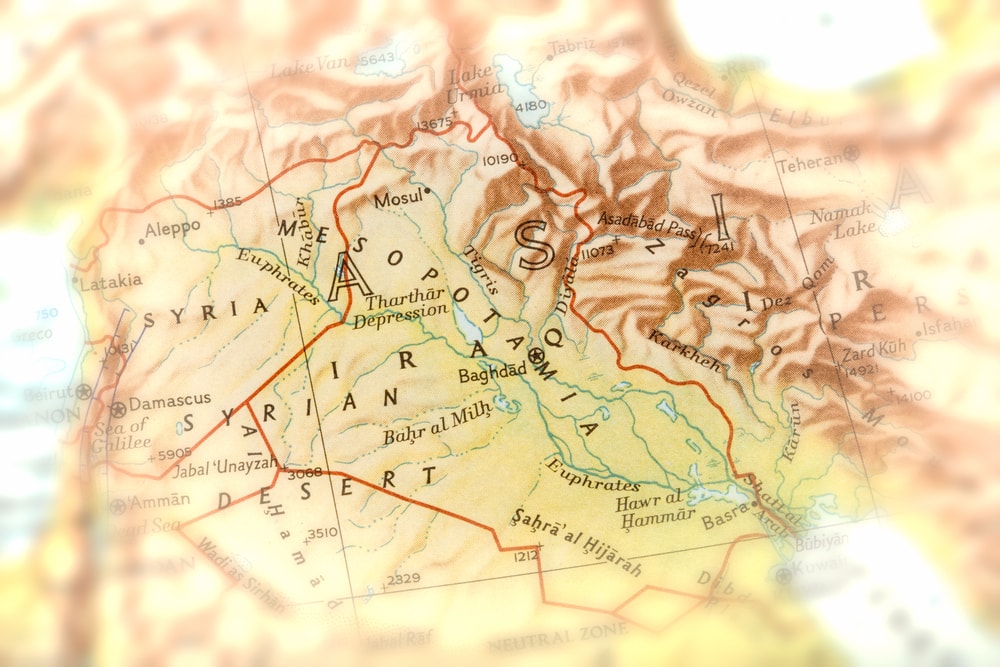
In Mesopotamia, turtles get associated with the water god Enki. In the myth of Ninurta and the Turtle, Enki created the turtle to fight Ninurta, who wanted to conquer the world. The turtle succeeded in stopping Ninurta by biting his ankle and dragging him into a pit.
China

One of the most important myths of creation involves a turtle. Pangu had the help of a turtle to create the world. This is how the turtle is a symbol of the universe. It stands for longevity and strength.
FAQ
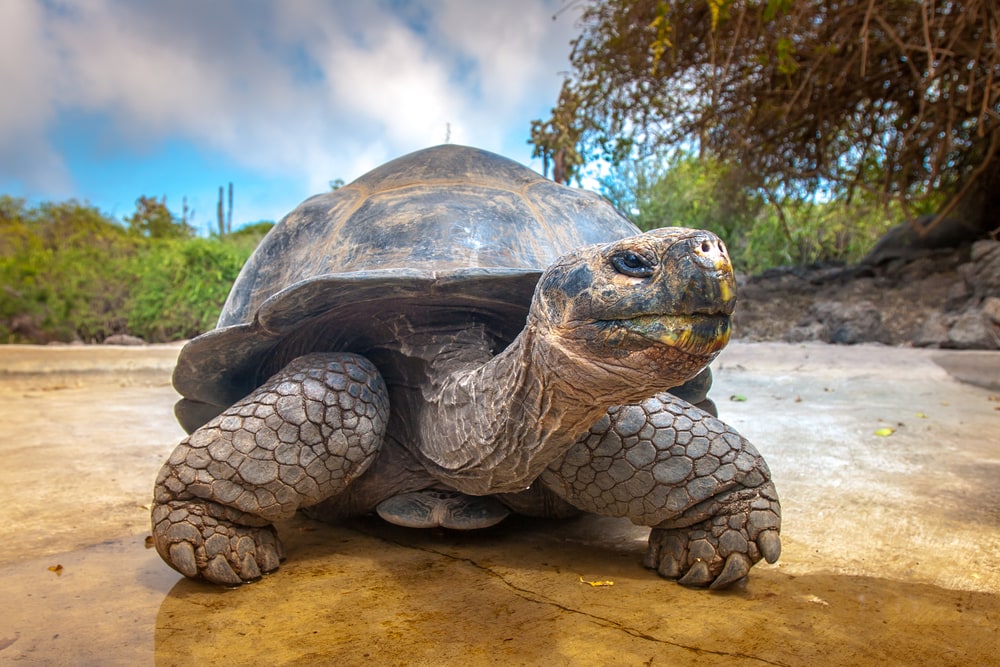
What kind of turtles are found in Michigan?
Michigan has 10 native species of turtles. They are mostly aquatic but some venture on land. The majority is omnivore with one species being carnivore.
What is the most common turtle in Michigan?
The most common turtle found in Michigan is the Red-eared Slider. This turtle is a common pet and is sold in pet shops.
You may also like:
Discover the different species found in Michigan here:

Fish In Lake Michigan | Snakes In Michigan | Frogs Of Michigan | Woodpeckers In Michigan | Michigan Water Snakes | Hawks In Michigan | Michigan Birds | Owls In Michigan








